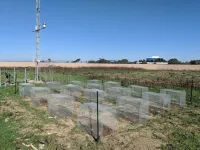Wireless and battery-free spintronic energy harvester
2021-05-19
(Press-News.org) Researchers at the National University of Singapore (NUS) and Tohoku University have demonstrated that an array of electrically connected spintronic devices can harvest a 2.4 GHz wireless signal, which can be used to power and charge small electronic devices and sensors.
The researchers from NUS and Tohoku University have successfully synchronized the four electrically connected magnetic tunnel junction (MTJ), for the signal transmission at 2.4 GHz. Furthermore, the eight MTJs array was integrated with the conventional battery-free electronics to harvest a wireless signal of 2.4 GHz to a DC signal, which is used to power light emitting diodes (LED).
"This breakthrough has proven the potential of an on-chip array of the MTJs towards high-frequency applications such as wireless transmission and energy harvesting," said Professor Hyunsoo Yang of NUS, who spearheaded the project.
With the increase of Wi-Fi sources everywhere in smart cities, the radio-frequency signal primarily at 2.4 GHz becomes an abundant source of energy harvesting. The radio-frequency energy harvester captures electromagnetic waves from the wireless sources and converts them into a usable DC signal, which can be utilized for wireless charging and self-sustained smart wireless sensors.
MTJs, a representative functional device of spintronics exploiting the spin degree of freedom of electrons, has already had an enormous impact on magnetic sensors and computing memories. The MTJ is expected to find application in wireless communication systems in the form of radio-frequency generation and high-frequency rectification. However, the commercial viability of high-frequency MTJs is hindered due to a typically low output power (nW) and broad linewidth (MHz). Mutual synchronization of multiple MTJs is one way to overcome this problem. However, an effective pathway to synchronize the MTJs at the Wi-Fi bandwidth has not been clear until now.
The researchers overcame this challenge by developing MTJs with canted anisotropy that can be electrically synchronized at a GHz-range using a single DC source. The MTJs were fabricated by Shunsuke Fukami's team at Tohoku University and the integration and measurement were performed by Hyunsoo Yang's team at the NUS. They found an efficient scheme to convert rf signal to DC at zero bias and zero magnetic field. Using this advantage, the rectified response of eight connected STOs in series is integrated with the conventional battery-free electronics to light up a 1.6 V LED.
This work opens a new avenue to realize wireless and battery-free sensors and processors. Enhancing the MTJ performance and increasing the number of MTJs are expected to make this technology useful in the new paradigm of IoT societies, where many more "things" can communicate via the Internet.
INFORMATION:
[Attachments] See images for this press release:

ELSE PRESS RELEASES FROM THIS DATE:
2021-05-19
In a world hungry for cheaper, more efficient renewable energy, Australian researchers have served up a treat.
Work led by the ARC Centre of Excellence in Exciton Science has shown that the two-dimensional (2D) thin films used in some perovskite solar cells closely resemble a sandwich. Perovskite is an exciting material at the forefront of solar energy research and design.
Previously, scientists thought these 2D perovskite films had a 'gradient' structure, in which certain components were found deep in the material, with other complementary elements only located nearer to the surface, like topping on a cracker.
However, in a paper published ...
2021-05-19
Nearly a quarter of pregnant women say they've been around secondhand smoke - in their homes, at work, around a friend or relative - which, according to new research, is linked to epigenetic changes - meaning changes to how genes are regulated rather than changes to the genetic code itself - in babies that could raise the risk of developmental disorders and cancer.
The study, published today in Environmental Health Perspectives by researchers at Virginia Commonwealth University Massey Cancer Center, is the first to connect secondhand smoke during pregnancy with epigenetic modifications to disease-related genes, measured at birth, which supports the idea that many adult ...
2021-05-19
While a pint-sized snorer may seem adorable tucked up in bed, studies shows that children with sleep disordered breathing are likely to show aggressive and hyperactive behaviours during the day.
The recommended treatment is an adenotonsillectomy - the removal of adenoid and tonsils - not only to fix the snore, but also the behaviour.
Yet according to new research from the University of South Australia, while the surgery can cure a child's snoring it doesn't change their behaviour, despite common misconceptions by parents and doctors alike.
Conducted in partnership with the University ...
2021-05-19
The nerve cells, also called neurons, in our brain control all the basic processes of our body. For this reason, there are different types of neurons distributed over specific regions of the brain. Researchers at the Max Planck Institute for Metabolic Research and the CECAD Cluster of Excellence in Aging Research of the University of Cologne have developed an approach that allows them to show that neurons that are supposedly the same are actually very different: they not only sense different hormones for the body's energy state, but also have a different influence on food intake. This can have a direct effect on our metabolism, for example by differentially restraining our appetite.
The brain processes our sensory perceptions, controls our behaviour and stores ...
2021-05-19
Traditionally, an infection is thought to happen when microbes - bacteria, fungi, or viruses - enter and multiply in the body, and its severity is associated with how prevalent the microbes are in the body.
Now, an international research team led by Nanyang Technological University, Singapore (NTU Singapore) has proposed a new way of understanding infections. Their study of close to 400 respiratory samples from patients with bronchiectasis, a chronic lung condition, has shown that microbes in the body exist as a network, and that an infection's severity could be a result of interactions between these microbes.
Through statistical modelling ...
2021-05-19
Among the large cast of microbiome players, bacteria have long been hogging the spotlight. But the single-celled organisms known as protists are finally getting the starring role they deserve.
A group of scientists who study the interactions between plants and microbes have released a new study detailing the dynamic relationships between soil-dwelling protists and developing plants, demonstrating that soil protists respond to plant signals much like bacteria do.
An enormous variety and diversity of microbes live in soil, and studying how these organisms interact with each ...
2021-05-19
For young plants, timing is just about everything. Now, scientists have found that herbivores, animals that consume plants, have a lot to say about evolution at this vulnerable life stage.
Once a plant seedling breaches the soil surface and begins to grow, a broad range of factors will determine whether it thrives or perishes.
Scientists have long perceived that natural selection favors early rising seeds. Seedlings that emerge early in the growing season should have a competitive advantage in monopolizing precious soil resources. Early growth also should mean more access to light, since early growers can block sunlight for seedlings that emerge later in the season.
Despite plenty of proof that germinating early is highly advantageous, many plants germinate ...
2021-05-19
LA JOLLA, CALIF. - May 19, 2021 - A study led by scientists at Sanford Burnham Prebys Medical Discovery Institute has identified a tumor marker that may be used to predict which breast cancer patients will experience resistance to endocrine therapy. The research offers a new approach to selecting patients for therapy that targets HER2, a protein that promotes the growth of cancer cells, to help avoid disease relapse or progression of endocrine-sensitive disease.
The study was published in the journal Nature Communications.
Nearly 80% of breast tumors are estrogen receptor (ER)-positive. For decades, ...
2021-05-19
Turns out the old adage, "monkey see, monkey do," does ring true -- even when it comes to cannabis use. However, when cannabis use involves youth it's see, think, then do, says a team of UBC Okanagan researchers.
The team found that kids who grow up in homes where parents consume cannabis will more than likely use it themselves. Parental influence on the use of cannabis is important to study as it can help with the development of effective prevention programs, explains Maya Pilin, a doctoral psychology student in the Irving K. Barber Faculty of Arts and Social Sciences.
"Adolescence is a critical period in which drug and alcohol experimentation takes place and when cannabis use is often initiated," says Pilin. "Parents are perhaps the most influential socializing agent for ...
2021-05-19
People with bipolar disorder may not take their medication because of side effects, fear of addiction and a preference for alternative treatment - according to research from Norfolk and Suffolk NHS Foundation Trust (NSFT) and the University of East Anglia (UEA).
Nearly half of people with bipolar disorder do not take their medication as prescribed leading to relapse, hospitalisation, and increased risk of suicide.
A new study, published today, reveals six key factors that stop people taking their medication as prescribed.
These include whether they are experiencing side effects, difficulties in remembering to take medication and a lack of support from family, friends and healthcare ...
LAST 30 PRESS RELEASES:
[Press-News.org] Wireless and battery-free spintronic energy harvester







